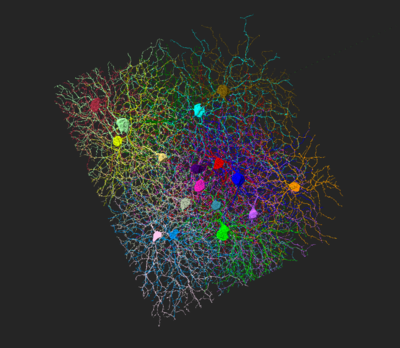DRD4-RGC
Cells that express dopamine receptor D4 (DRD4) are a neuronal cell type in the retina. They are a type of On-Off Direction-Selective Ganglion Cell (On-Off DSGC) that prefers posterior motion within the visual field (motion on the retina towards the nasal pole). Like other On-Off DSGC types, DRD4 cells have bistratified dendrites, and receive synaptic input from starburst amacrine cells. Their axons project to the dorsal lateral geniculate nucleus and the superior colliculus.
Contents
Molecular definition
These cells are defined by their expression of DRD4 (dopamine receptor D4). They can be visualized in Drd4-GFP BAC transgenic mice, in which GFP is expressed under the control of the Drd4 promoter (Gong et al., 2003). This mouse line expresses GFP prominently in the prefrontal cortex, and also in the ganglion cell layer (GCL) of the retina (Gong et al., 2003, Huberman et al., 2009). Dendrites of GFP-positive cells stratify in two distinct bands in the inner plexiform layer (IPL) of the retina, a pattern known as bistratification (Huberman et al., 2009). The GFP-positive dendrites appear to be costratified with processes of starburst amacrine cells (SACs).
Physiology
All DRD4-RGC cells are strongly excited by posterior motion within the visual field, or motion toward the nasal pole of the retina. ON and OFF responses are exhibited in response to flashes of a white spot centered on the soma (Huberman et al., 2009). Responses to drifting graftings reveal strong posterior direction tuning that is more narrowly tuned compared to another type of posterior motion preferring DSGC (TRHR-RGC) (Rivlin-Etzion et al., 2011).
Anatomy
Dendritic Morphology
DRD4-RGC cells exhibit canonical morphological characteristics of On-Off DSGCs. They are bistratified, costratifying with starburst amacrine cell (SAC) processes. Their dendritic fields are egg-shaped and arbors exhibit "looping" patterns prevalent in mouse On-Off DSGCs (Huberman et al., 2009). Although their dendritic arbors are mostly symmetric, their somas tend to shift slightly away from the center of their dendritic fields, which distinguishes them from another subtype of posterior motion perferring DSGC (TRHR-RGC). The cells form a regular mosaic with a relatively high coverage factor (2.99 on average) (Rivlin-Etzion et al., 2011).
Retinal Input
Although the exact cell types that DRD4-RGCs receive input from are still unknown, they are thought to exhibit the same overall connectivity as canonical DSGCs.
Central Projections
DRD4-RGCs send their axons to two retinorecipient areas of the brain: the dorsal lateral geniculate nucleus (dLGN) and the superior colliculus (SC). For both areas, axon terminations are restricted to specific laminae. In the dLGN, DRD4-RGC axons are limited to a lamina running along the lateral dLGN, while in the SC, axons terminate in the upper half of the stratum griseum superficialis (uSGS) (Huberman et al., 2009). Inputs to both dLGN and SC arise from the controlateral eye.


Behavioral Output
It is difficult at this stage to infer what information these On-Off DSGCs are contributing to in object motion detection. However, the highly specific nature of their central projections reveals several important truths about how DSGCs are computing object motion. Their axons target exclusively the dLGN and SC, with no terminations in any other retinorecipient area, including the accessory optic nuclei. The accessory optic nuclei receives input from On DSGCs, cells that respond to global visual movement, and are responsible for image stabilization. The axons that arise from DSGCs that detect posterior motion seem to belong to a completely different pathway than that of On DSGCs, and thus result in a completely different functional output. At this time, we know only that neurons in particular laminae of the dLGN and SC receive posterior motion input, and those neurons in turn process and project this information to the visual cortex (in the case of the dLGN).
History
Although the presence of On-Off DSGCs have been known since 1968, the central projections and molecular markers for each subtype of On-Off DSGC have not been fully uncovered. The use of transgenic mice has made this task increasingly easier. This particular subtype of On-Off DSGC was discovered by Huberman et al. in 2009.
References
Gong S, Zheng C, Doughty ML, Losos K, Didkovsky N, Schambra UB, Nowak NJ, Joyner A, LIblanc G, Hatten ME, Heintz N (2003). A gene expression atlas of the central nervous system based on bacterial artificial chromosomes. Nature 425, 917-925. PubMed Free full text
Huberman AD, Wei W, Elstrott J, Stafford BK, Feller MB, Barres BA (2009). Genetic identification of an On-Off direction selective ganglion cell subtype reveals a layer-specific subcortical map of posterior motion. Neuron 62, 327-334. PubMed Free PMC article
Rivlin-Etzion M, Zhou K, Wei W, Elstrott J, Nguyen PL, Barres BA, Huberman AD, Feller MB (2011). Transgenic mice reveal unexpected diversity of ON-Off direction selective ganglion cell subtypes and brain structures involved in motion processing. J Neurosci. 31, 8760-8769. PubMed Free PMC article
| ||||||||||||||||||||||||||||||||||||||||||||||||||||||||||||||||||



